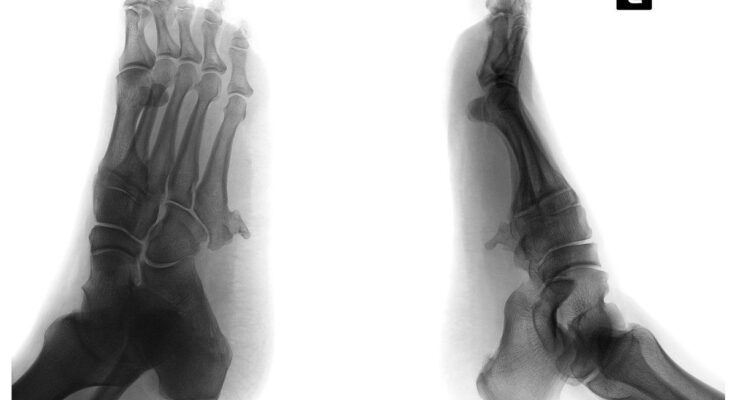This disease refers to a bony growth appearing in early childhood. It can be operated on in case of pain. What is the origin of this benign disease? How to make the diagnosis and what is the treatment for exostosis? Update with Doctor Olivier Fontes, orthopedic surgeon at the Parc clinic in Castelnau-le-Lez.
Exostosis, definition
Exostosis is a benign disease designating a bony outgrowth. Bony growths are generally metaphyseal, that is to say they are close to the joints between the long part of the bone and the joint.
Exostoses are found on the upper and lower body. They are quite common at the level
- of the knee;
- ankle;
- you tibia;
- wrist;
- of the forearm;
- of the humerus;
- of the skull;
- of the toe;
- of the shoulder;
- elbow;
- of the ear.
What causes a bone overgrowth?
Exostosis can be either isolated or multiple. Multiple exostosis has a genetic origin and isolated exostosis has a multifactorial origin.
- L’exostose multiple of genetic origin appears in childhood between birth and 20 years of age. Exostosis is located in several places (sporadic). It can be small and then begin to grow during the growth period of the child and adolescent. “It is always difficult to give a precise age of onset because it is often discovered later, in adulthood, when it becomes bothersome or during an x-ray for another cause. specifies Doctor Olivier Fontes, orthopedic surgeon at the Parc clinic in Castelnau-le-Lez.
- Isolated exostosis is of unclear origin (idiopathic). Unlike the multiple genetic form, this remains isolated to a single location. It can be post-traumatic (hematoma after a shock).
What are the symptoms of exostosis?
Exostosis is not always visible although it is often palpable. “Instead of feeling muscle under the fingers, we feel a bump, something hard (because the exostosis is covered by a cartilaginous covering) and which is not supposed to be there.indicates the surgeon.
Sometimes exostosis is visible. A protruding bone then appears under the skin, where one should not be seen. For example at the level of the tibia or humerus. The person may feel pain during certain movements. This pain is not directly linked to the exostosis but to the consequences because the exostosis appears in places where the tendons and ligaments pass.
The person also feels swelling, the range of movement is hampered indirectly due to the conflict between the ligaments and pain. The patient may feel joint limitation. “Exostosis cannot actually block a joint because it does not reach the epiphyses. indicates the specialist. “It can hamper movement because of the pain but it is an indirect blockage.”
Inflammatory phases can occur due to friction, during sports for example.
There is no skin impact (no dry skin).
How is exostosis diagnosed? Who to consult for an exostosis?
The general practitioner can confirm the exostosis by clinical diagnosis with palpation of the areas of pain and by requesting an x-ray. The imaging examination will allow differential diagnosis to rule out bone tumors and osteophytes in the elderly. “It's true that radiographically, we always underestimate exostosis because the x-ray will only see the bone.” recognizes Doctor Olivier Fontes. “There may be a small distortion between what we see on the radio and what we feel which may be larger. So the clinical examination is very important.”
A CT scan, a CT angiogram, an MRI may be prescribed in addition depending on the location of the exostosis. “These examinations are rather requested by the surgeon when exostosis appears in areas where noble anatomical structures such as nerves and arteries pass…”, specifies the specialist
Genetic exostosis is hereditary. “It would be autosomal dominant, that is to say that if one of the two parents carries the gene, they will transmit it to their child. reveals the specialist. “It is possible to search for genetic mutations by taking a blood test. The child carrying the gene will then enter a surveillance protocol.”
Exostosis should not be confused with Ollier's disease. It is a disease of bony growths, that is to say metaphyseal-diaphyseal chondromas, which begin in the first decade of life, congenital but without hereditary origin. “The disease occurs inside the bone., explains Doctor Olivier Fontes. “The bone tissue is replaced by a cartilaginous matrix which can cause swelling under the skin, it is the radiographic appearance which will make the difference with an exostosis.
How to treat exostosis? How to cure exostosis? And who performs an exostosis?
Exostosis is completely benign.
Treatment of exostosis with incidental discovery
If the patient does not complain about anythingmonitoring will be implemented with an annual x-ray.
If exostosis becomes symptomatic with damage to the surrounding structures, surgical excision will be performed by the orthopedic surgeon in the clinic. Everything will depend on the bone, the location and the complexity regarding the duration of the operation. “A remote exostosis of all vascular nervous structures will take no more than 20 minutes and will be performed on an outpatient basis,” explains the expert. “Since we are forced to perform more delicate procedures, the surgery will be a little more invasive, which will require 1 hour of intervention.
Isolated exostosis, once surgically removed, does not return. Rehabilitation will serve to restore mobility to the joint. Convalescence will be one week for sedentary work and 3 weeks for physical work.
Children can also be operated on when the exostosis is bothersome and painful.
Treatment of genetic exostosis
There is a risk of malignant degradation (between 0.5 and 5% of cases). Regular monitoring is therefore very important. Especially during the growth period. X-ray monitoring will take place once a year and then spaced out once growth is complete.
Several operations will certainly be performed over the course of life since genetic exostoses tend to recur continuously. One is surgically removed in one place and another appears elsewhere.
What are the symptoms of a benign bone tumor?
The telltale signs of a bone tumor are more or less severe pain, local swelling or a spontaneous fracture.
How to treat ear exostosis?
Small bony growths can also appear in the ear during intense sporting activity. This is the case with surfers. These small growths then reduce the caliber of the conduit. Repeated falls into the water would be the cause. Water trapped in the ear is difficult to escape. Surgery to widen the ear canal can help.




